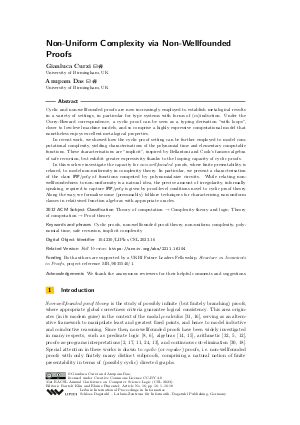@InProceedings{curzi_et_al:LIPIcs.CSL.2023.16,
author = {Curzi, Gianluca and Das, Anupam},
title = {{Non-Uniform Complexity via Non-Wellfounded Proofs}},
booktitle = {31st EACSL Annual Conference on Computer Science Logic (CSL 2023)},
pages = {16:1--16:18},
series = {Leibniz International Proceedings in Informatics (LIPIcs)},
ISBN = {978-3-95977-264-8},
ISSN = {1868-8969},
year = {2023},
volume = {252},
editor = {Klin, Bartek and Pimentel, Elaine},
publisher = {Schloss Dagstuhl -- Leibniz-Zentrum f{\"u}r Informatik},
address = {Dagstuhl, Germany},
URL = {https://drops.dagstuhl.de/entities/document/10.4230/LIPIcs.CSL.2023.16},
URN = {urn:nbn:de:0030-drops-174770},
doi = {10.4230/LIPIcs.CSL.2023.16},
annote = {Keywords: Cyclic proofs, non-wellfounded proof-theory, non-uniform complexity, polynomial time, safe recursion, implicit complexity}
}

 Creative Commons Attribution 4.0 International license
Creative Commons Attribution 4.0 International license










